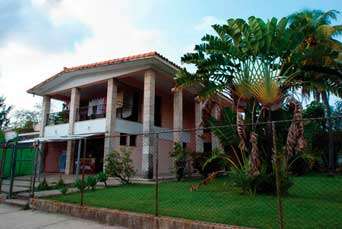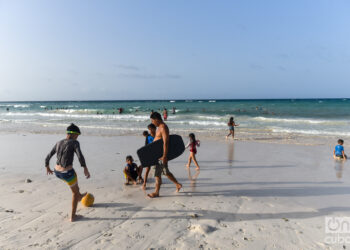Photos: Alain L. Gutiérrez
As one of modern-day Havana’s urban development projects (neighborhoods), Altahabana is probably among those that best preserve their integrity and authenticity. Our “little boxes” are just a modest urban planning solution within which the miracle of this coveted sustainability has occurred; at least, that is, from a purely social standpoint. It is a suburb in which urban planning standards made it possible to create an identifiable community for pursuing real quality of life.
Built during the 1950s by the Insured Mortgage Fund (FHA) program, with financing from Banco Núñez and planning by architects and engineers of the San Martín firm, the project was based on an interesting urban development concept. Initially, it occupied a triangular area between three major Havana roads: 100, Boyeros and Vento, which is why it may be the neighborhood with the best access to the city.
Basic principles of road development and good solar orientation were used, as well as a buffer zone to alleviate annoyances caused by the Ranchos Boyeros highway. It is unquestionably a clear example of well thought-out, discreet planning that uses green spaces, with a division of narrow blocks delimited by curving streets that converge at a tree-lined park on the banks of a creek.
The green area was very well-conceived with the purpose of making the pedestrian movement pleasant. And we can’t leave out the highly visual quality of Calle Vento as it run through Altahabana, especially the meters for Albear Acqueduct that are located on that street: small, dome-topped cylinders built in a neoclassical engineering style and encircled by the grass of the central divider.
From the start, planning for this neighborhood included excellent services; we should mention the Minimax (shopping center), also designed by the San Martín firm, which has been the urban landmark of Altahabana over the years. It is an extravagant building, with a vertical volume of questionable functionality and concessions to formalism, because it clearly imitates an airport control tower. However, the quality of the construction and materials (terrazzo and black granite veneer), as well as an extensive area of shop windows that facilitates an almost spectacular interior/exterior relationship, helps this building to maintain a dignity that causes us to be optimistic and to hope for a future recovery.
Most of the homes are one-story single-family houses. Their dimensions were the result of a combination of very similar units, which produced six main types: all have two or three bedrooms, living/dining room, maid’s room, kitchen, service yard, porch and carport.
In their formal aspects, these homes are austere, but their simplicity acquires an air of distinction from the modest shine of the ever-present terrazzo, a false granite that is as enduring as it is attractive, and above all, by the cleanness of interior spaces that have no unnecessary divisions and gardens that are well-proportioned and sufficiently spacious.
Some homes were not part of the original plan. They were created specifically for their parcels, and reflect high-quality design, following two modern Cuban tendencies: one that uses exposed brick and clay tiles, which is the most common, and one using white walls and pergolas, parapets and even murals by avant-garde artists. One example of the first tendency is 9903 Calle D, which features a cheerful folded plate canopy and sections of brick lattice. Examples of the second tendency include a two-story house at 17002 3ra, which reflects an experiment with a two-story facade, surprisingly modern according to architectural tendencies, and the discreet but very well-made house at 17011 Parque. The most interesting murals were created from ceramic tiles by Marta Arjona in 1957, for a house with a vaulted roof located on Calle 9 between A and B streets. One of the murals depicts a dove with outspread wings, adding gracefulness to the dynamic quality of the roof.
Generally speaking, the most outstanding houses were designed based on a sloped roof, like the one planned by Rosa América Mas Espinosa (17007 3ra), with a large section of red tiles that can be seen from a distance. A neoplástica influence can be seen in a two-story house at 9310 B street, and a very-well achieved organic quality can be seen in the home where Emilio Escobar lived (10103 Calle D), planned by Vicente Lanz and Margot del Pozo and made more interesting with landscaping designed by Thelma Esnard. This house masterfully unites a functional solution to privacy with aesthetic intention, with the yard’s vegetation entering the central living area, which functions as a space that joins two main areas.
The house at 15016 Calle G deserves a special mention, solving the corner with interlocking volumes and planes that frame an access road, and the entire composition is highlighted by a water tank with a sculptural form.
All of the houses are sufficiently set apart from each other so as not to create conflicts among neighbors, but at the same time, their proximity makes communication viable. The presence of individual porches contributes to the tradition of visits among those who share the neighborhood and to developing a notable sense of belonging.
In this case, the urban structure provided a sense of community, while the permanence of social groups, and the continuity which was achieved, developed the community’s identification with itself and with its environment, so that its inhabitants have done everything possible to avoid changing their homes and to maintain well-kept gardens. In fact, the interiors of homes inhabited by their original families or their descendants contain the same furniture and fittings, not just for economic reasons, but also for their nostalgic value.
Altahabana is slowly becoming more attractive, which is evidenced by the repair and painting of homes, leading to the assumption that this is because of the neighborhood’s enduring value. If that is the case, and if that rebirth implies more urban control and the improvement of its infrastructure, it may be expected – above all because of its founders’ and descendants’ aforementioned sense of belonging – that Altahabana could eventually become an example of an urban development that preserves its attributes and vindicates simple modernity, with few pretensions and many achievements.










